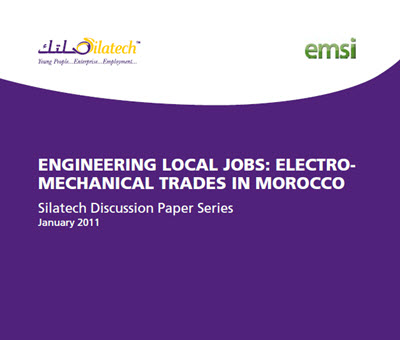This discussion paper highlights areas where strategic investment in Morocco is likely to create jobs and have strong economic returns.
Specifically, it focuses on targeted investment that would ease the burden on industry growth by producing resources currently imported from outside of Morocco. Morocco is keenly aware and proactively pursuing most of the areas where gaps in its economy exist. However, one area of opportunity is developing skilled human capital—many Moroccan industries have sought to make up for this shortage by importing skilled workers; other industries have not and are suffering as a result. Although Morocco has a large labor supply, much of it is unskilled. Moreover, for those with skills, there are often structural barriers to enter the workforce. Across the economy, expertise is brought in from outside of the country, but nowhere is this more evident than in engineering.
In this study, we look at engineers and workers in electro-mechanical trades, which provide much of the work necessary to support newly built infrastructure. These occupation clusters are important to the economy and are promising targets for investments in training. In particular, electro-mechanical trades represent a short-term goal for people looking for work, while also being a first step toward a long-term goal of full engineering training because of a common base level of skills.
Successes and Challenges
In many ways, Morocco has been a recent economic development success story. The government has spearheaded corporate privatization and financial reforms, signed free trade agreements, created world-class seaports, aided the modernization of existing industries, expanded modern infrastructure, marketed and provided opportunities for offshoring, helped establish Morocco as a top global tourist destination, and encouraged a well-educated population. As a result of these investments and other reforms, Morocco has expanded output and seen an increase in employment in recent decades.
However, the nation faces some challenges:
- High government debt
- Individual tax rates of 40% on those earning more than US $1550 per month
- High population growth
- Very low employment-to-population ratio of 46%
- Urban youth unemployment estimated as high as 33%
In addition, key sectors of the economy remain susceptible to outside forces:
- The agricultural sector accounts for approximately 45% of total employment but only 15% of GDP. In years with scant rainfall, GDP falls anywhere from 1% to 6%. In years of bumper crops, GDP increases by 1% to 4%.
- Tourism is expanding with construction of several high-end coastal resorts, but the sector has also been hit hard by economic downturns and creates low-skill, low-wage jobs.
- Morocco is the largest exporter of phosphorous and allied chemicals in the world, an activity which accounts for approximately 12% of all exports.
- The nation imports nearly 90% of its annual energy needs.
- The industrial sector accounts for 30% of GDP but only 20% of the workforce.
Focus on High and Middle Skills
Low-skill workers are not considered in this report because from an industry perspective they are the easiest workers to hire. Middle- and high-skill workers are much harder to come by because they need to have specific skills that are not in large supply. With low-skill workers, an efficient worker may be twice as productive as an inefficient one, but with middle- and high-skill workers, efficient workers may be five or ten times more productive.
Industry success relies on the smaller group of skilled workers performing their jobs well, which drives the output of the industry as a whole. When industries cannot find high-quality workers, they have three options: a) import labor, b) hire workers of lesser quality who will hurt performance, or c) not hire at all. Industries in this position also will have fewer low-skill workers, as industry growth and capacity are directly impacted by a lack of skilled workers. Lifting constraints, then, on middle- and high-skill workers opens doors for low-skill workers.

